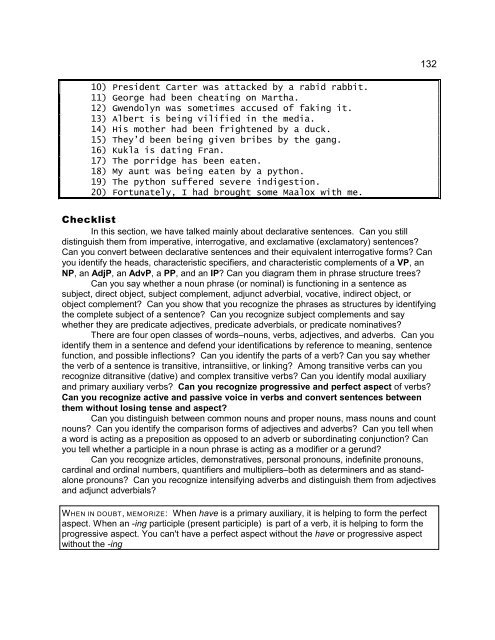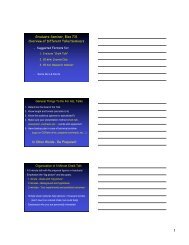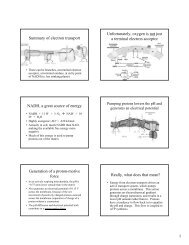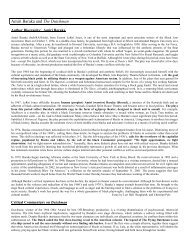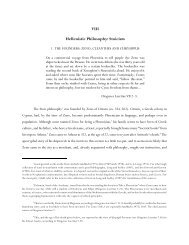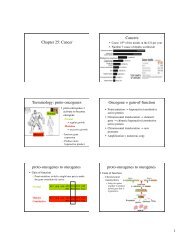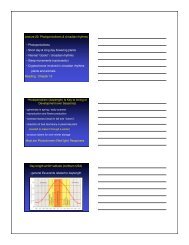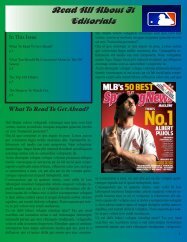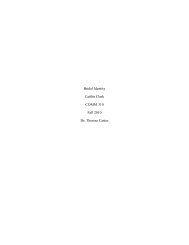V. VERB QUALITIES - UW-Parkside: Help for Personal Homepages
V. VERB QUALITIES - UW-Parkside: Help for Personal Homepages
V. VERB QUALITIES - UW-Parkside: Help for Personal Homepages
Create successful ePaper yourself
Turn your PDF publications into a flip-book with our unique Google optimized e-Paper software.
10) President Carter was attacked by a rabid rabbit.<br />
11) George had been cheating on Martha.<br />
12) Gwendolyn was sometimes accused of faking it.<br />
13) Albert is being vilified in the media.<br />
14) His mother had been frightened by a duck.<br />
15) They’d been being given bribes by the gang.<br />
16) Kukla is dating Fran.<br />
17) The porridge has been eaten.<br />
18) My aunt was being eaten by a python.<br />
19) The python suffered severe indigestion.<br />
20) Fortunately, I had brought some Maalox with me.<br />
Checklist<br />
In this section, we have talked mainly about declarative sentences. Can you still<br />
distinguish them from imperative, interrogative, and exclamative (exclamatory) sentences?<br />
Can you convert between declarative sentences and their equivalent interrogative <strong>for</strong>ms? Can<br />
you identify the heads, characteristic specifiers, and characteristic complements of a VP, an<br />
NP, an AdjP, an AdvP, a PP, and an IP? Can you diagram them in phrase structure trees?<br />
Can you say whether a noun phrase (or nominal) is functioning in a sentence as<br />
subject, direct object, subject complement, adjunct adverbial, vocative, indirect object, or<br />
object complement? Can you show that you recognize the phrases as structures by identifying<br />
the complete subject of a sentence? Can you recognize subject complements and say<br />
whether they are predicate adjectives, predicate adverbials, or predicate nominatives?<br />
There are four open classes of words–nouns, verbs, adjectives, and adverbs. Can you<br />
identify them in a sentence and defend your identifications by reference to meaning, sentence<br />
function, and possible inflections? Can you identify the parts of a verb? Can you say whether<br />
the verb of a sentence is transitive, intransiitive, or linking? Among transitive verbs can you<br />
recognize ditransitive (dative) and complex transitive verbs? Can you identify modal auxiliary<br />
and primary auxiliary verbs? Can you recognize progressive and perfect aspect of verbs?<br />
Can you recognize active and passive voice in verbs and convert sentences between<br />
them without losing tense and aspect?<br />
Can you distinguish between common nouns and proper nouns, mass nouns and count<br />
nouns? Can you identify the comparison <strong>for</strong>ms of adjectives and adverbs? Can you tell when<br />
a word is acting as a preposition as opposed to an adverb or subordinating conjunction? Can<br />
you tell whether a participle in a noun phrase is acting as a modifier or a gerund?<br />
Can you recognize articles, demonstratives, personal pronouns, indefinite pronouns,<br />
cardinal and ordinal numbers, quantifiers and multipliers–both as determiners and as standalone<br />
pronouns? Can you recognize intensifying adverbs and distinguish them from adjectives<br />
and adjunct adverbials?<br />
WHEN IN DOUBT, MEMORIZE: When have is a primary auxiliary, it is helping to <strong>for</strong>m the perfect<br />
aspect. When an -ing participle (present participle) is part of a verb, it is helping to <strong>for</strong>m the<br />
progressive aspect. You can't have a perfect aspect without the have or progressive aspect<br />
without the -ing<br />
132


